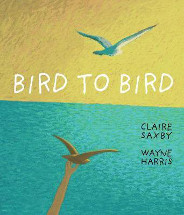Bird to bird by Claire Saxby

Ill. by Wayne Harris. Black Dog Books, 2018. ISBN 9781925381122
(Age: 4+) Highly recommended. Themes: Birds, Trees, Convicts. In
following the life of just one tree, Saxby and Harris reveal the
European settlement of Australia, as the wood from the tree is used
to build ships that are used to bring the convicts to Sydney, then
reused to make a loom, reused again as part of a settler's hut, and
then a part of the now derelict hut is fashioned by a wood turner.
In the beginning the tree grows from a seedling born out of a seed
dropped by a bird flying overhead. The wood turner at the end
fashions his piece of wood into a bird, completing the circle of
life for the tree, bringing the story back to its roots.
Readers will eagerly follow the story of the tree from the seedling
to the bird being used by children at the end. The bold
illustrations show the tree as a seedling, growing to an enormous
tree in the forest, used by birds until it is felled by woodsmen.
They take the tree to the hungry city where ships are built and beds
made in the ships for the convicts on their journey across the seas
to Australia. Here the wood becomes a loom to fashion the wool, and
when this is no longer used, it makes the roof of a settlers hut,
until it is used by the wood turner to fashion a bird.
The sparse text reminds the readers of the uses to which just one
tree can be put, and reflect the cyclic nature of life. The
wonderful illustrations reference early Australian paintings,
particularly of Sydney Harbour, and the style Harris uses recalls
for me the techniques of impressionist painters such as van Gogh and
Georges Seurat.
The book extols the virtue of recycling, of reusing resources,
showing a perspective of Australia's history through the wood used
to bring people here, but then reused many times to get the most
from it. A gentle story of Australia's beginnings is given a broader
scope through the illustrations showing Australia through time;
beginning with the convict ships arriving on Sydney's shore to the
building of looms to prepare cloth, the settlers' huts miles from
the city, then back to the place it started, the harbour where
children play with the last product of the original tree.
Fran Knight